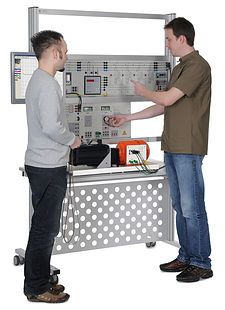Energy Management
Energy Management
For economic and environmental reasons, a rational use of energy is becoming increasingly important. Exercises on manual and automatic compensation of reactive power as well as experiments on reducing peak loads through measurements with active-current and maximum-demand meters demonstrate how the load on an electricity supply network can be reduced and evenly distributed over a 24-hour period. An analysis of the power supply grid and connected consumers (loads) is necessary for effective use of the involved measurement techniques. Accordingly, each experiment permits a detailed investigation of static, dynamic, symmetric and asymmetric loads. Protection of electrical consumers is another important training subject.

Experiments on reducing peak loads through measurements with active-current and maximum-demand meters demonstrate how the load on an electricity supply network can be reduced and evenly distributed over a 24-hour period. An analysis of the power supply grid and connected consumers (loads) is necessary for effective use of the measurement techniques involved. Accordingly, each experiment permits a detailed investigation of static, dynamic, symmetric and asymmetric loads.
In this case, a three-phase asynchronous motor coupled with the servo machine test stand is used as a dynamic load. The active and reactive power (cos-phi for the motor) depend on the motor load and are therefore not constant. The servo machine test stand can be used to drive the asynchronous motor, thereby feeding active power into the three-phase network.
Reactive power compensation in alternating voltage networks is designed to reduce undesirable reactive current and resulting reactive power at the consumers. In this process, capacitive loads are connected to all inductive loads via a central feed point. The opposing, capacitive reactive power arising here is ideally of the same magnitude as the installed, inductive reactive power. This reduces undesirable reactive currents and none of the systems needed to supply the reactive current has to be of excessive size.

Malfunctions in electrical systems resulting from short circuits, overload etc. must be prevented or at least restricted by means of appropriate protective measures, and the faulty devices disconnected selectively from the network. For the protective features to be properly implemented and correctly dimensioned, it is necessary to know their trigger characteristics and times, as well as their operational characteristics.